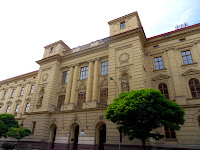
I've been living in the ČR for almost 15 months now. In a lot of ways I feel like I'm getting used to things and at times I still feel like a fish out of water.
It helps to remind myself at times that I'm not in a foreign country. But rather I'm a foreigner in this country.
A minor difference, I know, but one that helps me quite a bit when I feel overwhelmed.
There are lots of little things here that continue to remind me that I'm not in Atlanta anymore. Even paper is different over here.
Not that this is a big deal at all. But it is just one of those little daily reminders that things are different.

In North America, the standard piece of paper is letter size, which is 8½ x 11 inches (or 216 x 279 mm). But in most of the world the standard piece of paper is A4, which is 8.27 x 11.7 inches (or 210 x 297 mm). So European paper is longer but not quite as wide as what we use back in the U.S.
My friend, Armelia, gave be a beautiful leather portfolio with my initials on it several years ago when I earned my bachelor's degree. I have letter size tablets sent over from the U.S. because the A4 paper doesn't quite fit.
The only other time that it can be an issue is when you need to reformat your work in order to print. A A4 document must be reformatted to print on letter size paper or information at the bottom of the longer A4 page could be lost. This also can cause page numbering and reference errors when dealing with word processing software.
A useful tip I learned was when photocopying letter size papes to A4 paper you need to reduce the pages to 97% in order for everything to fit the narrower page. When copying A4 to letter size then you need to reduce the page to 94% to fit the shorter paper.
And you only find 3 hole paper in the U.S. Here there are usually 4 holes.
 So while walking around Zlín's main square we noticed that it looked like a wedding party was getting ready to exit the city hall building. What caught my attention was that there were five baton twirling majorettes out in front. Uh huh. Well that's kind of different.
So while walking around Zlín's main square we noticed that it looked like a wedding party was getting ready to exit the city hall building. What caught my attention was that there were five baton twirling majorettes out in front. Uh huh. Well that's kind of different. I guess the bride was a hardcore majorette herself because then she had a wedding baton and was out in front twirling away. I can honestly say that I've never seen this before. But I guess to each their own.
I guess the bride was a hardcore majorette herself because then she had a wedding baton and was out in front twirling away. I can honestly say that I've never seen this before. But I guess to each their own.















